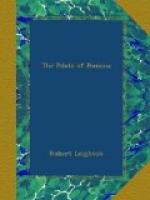Now the name Thora is not a common one in Orkney, and seeing it on that strange old tombstone naturally made me think of the Thora whom I knew—Tom Kinlay’s sister.
“Tom, did you ever notice the name on this grave? It’s some woman buried here named Thora.”
He turned and read the inscription.
“Ay, I’ve seen it before. It’s some woman that was found drowned at the foot of the Black Craigs, years ago. I dinna ken who she was. I think she was in a shipwreck.”
“Oh! Then it was no relation of yours?”
“No. That is, I dinna think it. But I have heard that Thora was named after her.”
I asked him to tell me about the wreck; but just then Willie Hercus interrupted, saying:
“Come along, Ericson; you had better be the one to divide the treasure for us. We all ken you’ll divide it fairly.”
The treasure was heaped upon the tombstone, and as I regarded it I foresaw the difficulty of the task before me; for the pieces were obviously of very varied values, and I did not see how I could easily distribute them into four equal shares. But I made the attempt according to the manner that I had seen adopted by the fishermen at Stromness in dividing their fish.
To begin with, there was the sword—apparently the most valuable of all the treasures. Who was to have this? I naturally thought it should go to Hercus, to whom we owed our possession of the wealth, and I remembered that Kinlay already had an equivalent share in the pieces of broken helmet he had appropriated. I handed the sword over to Hercus, therefore. Tom offered no opposition at the time, but he afterwards bartered with Hercus for it, giving him in exchange two of the ingots of silver and the coat of mail which subsequently fell to his share.
The sword and the coat of mail being apportioned to Hercus and Kinlay, I then gave the bronze belt to Rosson, and took for myself some pieces of armour and a fragment of a shield. Then there were twenty-two ingots, or bars of silver, each of about six ounces in weight. Five of these were apportioned to each of us, two being left to be dealt with afterwards.
Next, there were thirteen brooches, such as the Scandinavians—as I learned later on—were accustomed to use for binding their mantles. They were all of similar pattern, and would weigh, perhaps, three ounces each. Of them we had three apiece. There were three massive torques, or rings, something in the form of horseshoes, the opening being left to admit of their being fastened upon the neck, where the ornaments were worn, I believe, by the ancients as symbols of rank or command. These articles were composed of a series of rings interlaced, some of them being embossed with rude but curious designs.




